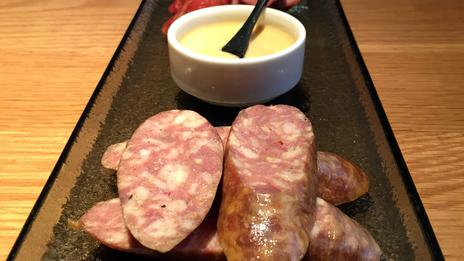This post may contain affiliate links. We may earn money or products from the highlighted keywords or companies or banners mentioned in this post.
A friend in Washington DC recently told me that the one dish most associated with the US capital was something called a half-smoke. I was stunned. I’d lived on the East Coast for more than a decade and had eaten far and wide, but I’d never heard of such a thing.

Apparently I was in pretty good company. When US President Barack Obama visited the Washington DC institution Ben’s Chili Bowl shortly before his inauguration in 2009, he reportedly asked, “What’s a half-smoke?” He was promptly served one and now knows, or at least thinks he does. So does former French president Nicolas Sarkozy, who made his own pilgrimage to Ben’s.
Yes, Baltimore has crab cakes. New York City has pastrami. Chicago has deep-dish pizza. And Washington DC – it turns out – has half-smokes.
The thing is, a little research revealed that no one is exactly sure who made the first half-smoke, or what, exactly, a half-smoke should be. This sausage on a bun is sometimes covered in chili, sometimes topped with cheese or diced onions, and sometimes doused with mustard. It’s most associated with Weenie Beenie (2680 South Shirlington Rd, 703-671-6661), which started slinging half-smokes in 1954 in nearby Arlington, Virginia, and Ben’s Chili Bowl, which opened in 1958.
A few days after chatting with my friend, I was in Washington DC, sitting at a table at Red Apron, a small chain of butcher shops with in-house eateries. With me were food writer Nevin Martell and Nate Anda, head butcher at Red Apron.
“It’s only been recently that chefs have embraced the half-smoke,” Martell said. “Only in the last few years have local chefs decided to put a half-smoke on the menu.”
Why and how the half-smoke suddenly became the DC food is as much a mystery as the sausage itself. “It’s a mythical sausage,” Anda said. “No one even knows what the ‘half’ is in the name.”
Perhaps the sausage got its name because it’s often half beef and half pork. Or it could be because some restaurants cut a slit down the top, nearly slicing it in half. The “smoke” could come from the fact that the sausage is smoked before it’s grilled.
As Martell noted, the mystery doesn’t stop at the name: “No one can agree what goes in a proper half-smoke. Is it topped with chili? If so, what’s in the chili? Is the ratio of meat half beef, half pork? Should you put cheese on it? What kind of spices should you use?” (Obama reportedly asked for cheese to be added, calling out, “not the Velveeta” kind.)
“The problem,” Anda said, “is that Ben’s and Weenie Beenie, which everyone looks to as the standard of the half-smoke, have never revealed their recipes. As a result chefs have interpreted the half-smoke their own way.”
Just then a server set a rectangular cutting board on our table. On it were sausage slices stacked alongside a small bowl of mustard. This was Red Apron’s interpretation, created by Anda. On one side was his partly smoked and grilled version and on the other, quite uniquely, a smoked and pickled version. I picked up a slice of grilled sausage and popped it in my mouth. Red Apron does a 50-50 split between pork and beef with a 75-25 split between meat and fat. I bit down and found the meat unctuous with a bit of spice lingering on my palate. There was also a slight undertone of dark porter beer, which Red Apron uses in the emulsion process. It was good. I liked it. But then I tried the pickled version.
- Red Apron's pickled half-smokes.
It was like nothing I’d ever tasted. This paler sausage was complex and extremely flavourful. I could detect aspects of apple cider vinegar, an essence of sugar and a tingle of cayenne, all of which Red Apron uses in the mixing process. It reminded me of a dish you’d find in Vietnam, a country whose culinary tradition often captures sweet, savoury, sour and spicy all at once. Red Apron’s pickled half-smoke did all this in one sausage.











